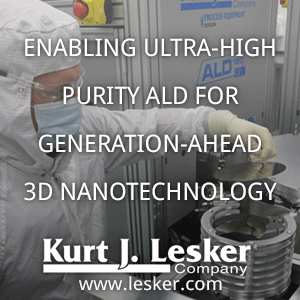As reported by
Oxford Instruments: Researchers at the Eindhoven University of Technology (TU/e) have
developed a novel approach to prepare TCOs consisting of H-doped indium
oxide (In
2O
3:H) which are both highly conductive
and highly transparent. Using an Oxford Instruments’ Atomic Layer
Deposition (ALD) system, the team was able to prepare amorphous In
2O
3:H
at 100 °C by ALD, followed by a brief solid phase crystallization step
at 200 °C. In comparison to conventional sputtered Sn-doped indium oxide
(ITO), the salient feature of the ALD In2O3:H process is the superior
electron mobility (138 cm
2/Vs), which simultaneously enables a lower resistivity (0.26 mΩ cm) and a negligible free carrier absorption in the infrared.
Research highlighted on cover of rapid research letters.
Reference: Macco et al., Phys. Status Solidi RRL 8, No. 12, 987–990 (2014)
Oxford Instruments’ popular FlexAL® and OpAL® tools allow both the
deposition of the amorphous indium oxide as well as the subsequent
crystallization at modest temperatures of 150 to 200 °C. The high
conductivity and high transparency, in conjunction with the
low-temperature, soft processing, makes the presented approach
especially promising for the application of the TCO in silicon
heterojunction solar cells.
“Prof. Kessels and the Plasma and Materials Processing (PMP) group at
TU/e continue to conduct exciting research using our ALD systems within
new application areas”, said Oxford Instruments Plasma Technology’s ALD
Product Manager, Chris Hodson, “This key technology advance is of real
interest to the solar cell research community, and I’m certain our
continuing collaboration with TU/e will bring additional advances in
this and other technology areas.”

Erwin Kessels from Eindhoven University of Technology (TU/e) is
spearheading efforts to translate smart nanotechnology inventions into
economically viable industrial processes and products, for instance
solar cells. Currently, most solar cells on the market are made up of
crystalline silicon. While researchers have achieved more than 25 per
cent energy conversion efficiency with this type of cell, the efficiency
of commercially available solar cells, such as those lying on top of
roofs, are so far only between 16 and 19 per cent. (Photo: Bart van
Overbeeke. http://www.technologist.eu/erwin-kessels-pursuing-the-art-of-making/)
Prof. Kessels comments, “There is still a lot of potential for
improving solar cells by thin films prepared by ALD, it is a very
versatile technique yielding the highest quality films at low
temperatures, without inducing damage, and with an unparalleled level of
growth control. These are merits yielding opportunities for virtually
all types of solar cells.”




%20(1).png)
